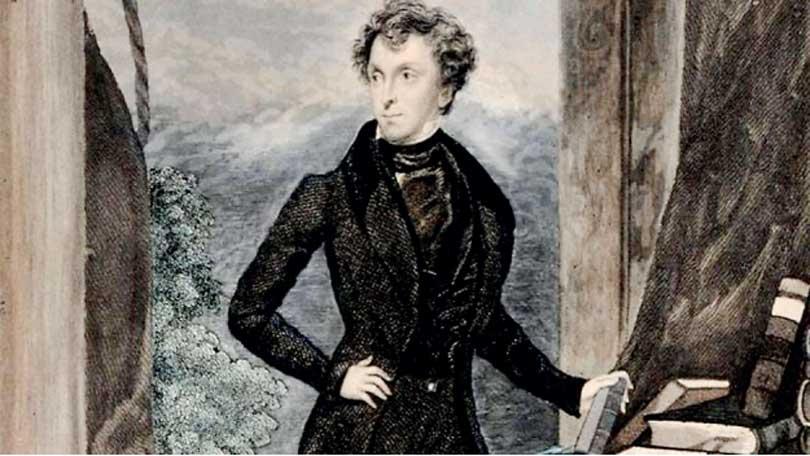06 Apr 2021 - {{hitsCtrl.values.hits}}

Sir James Emerson Tennent
 James Emerson Tennent was Colonial Secretary in Ceylon from 1846 to 1850 and Acting Governor in April-May 1847. Tennent was not just an administrator, a Colonial master lording over obsequious natives. His keen eye and ear caught the nuances of the communities he was administering. His scholarship got him the Presidency of the Ceylon branch of the Royal Asiatic Society.
James Emerson Tennent was Colonial Secretary in Ceylon from 1846 to 1850 and Acting Governor in April-May 1847. Tennent was not just an administrator, a Colonial master lording over obsequious natives. His keen eye and ear caught the nuances of the communities he was administering. His scholarship got him the Presidency of the Ceylon branch of the Royal Asiatic Society.
In “Christianity in Ceylon” published in 1850, Tennent traces its encounters with, and the challenges it faced from, entrenched faiths like Buddhism, Hinduism, Islam and demon worship and how it tried to overcome the odds. He also wrote on the Dutch attempt to root out Catholicism from Ceylon and the educational achievements of the American missions in Jaffna.
Contrary to the general belief that the Portuguese used violence to spread their religion in Ceylon, Tennent says: “There is no proof that compulsion was resorted to by them for the extension of their own faith or violence employed for the extinction of national superstitions.” By “national superstitions” he meant the other faiths.
He then goes on to say: “The probability is that the priests and missionaries of the Portuguese were content to pursue in Ceylon the same line of policy and adopt the same expedients for conversion which had already been found successful by their fellow laborers on the opposite continent of India.”
Both in India and Ceylon, the cultural tools used by the Catholic missionaries had proved to be more effective than coercion and violence. Another reason for the preference for cultural tools was that the Portuguese missionaries in India and Ceylon could not count on the support of the Portuguese State apparatus which was necessary to use coercive methods.
“The amount of assistance from civil power, on which the Roman Catholic clergy could rely, did not ordinarily extend beyond the personal influence of the Captains-General at Colombo,” Tennent says and adds that if at all there was State assistance these were “favors and partiality exhibited by successive Governors to all who were willing to conform to their religion.”
Conversions were facilitated by what, in his view, was a characteristic disposition of the Sinhalese to be “obsequious” and “pliant” to those in power. But when the use of power exceeded limits people resisted in a variety of ways. The might of the State did not work to the advantage of the Dutch because what they got, in reality, were fake adherents who lapsed into Buddhism or Hinduism the moment Dutch rule weakened.
 Sinhalese Buddhists as well as Tamil Hindus found Roman Catholic forms of worship similar and congenial, making transition from one to the other or dual allegiance, much easier. On the contrary, the forms of worship in the Protestant churches, marked by “stern simplicity” were seen as being alien
Sinhalese Buddhists as well as Tamil Hindus found Roman Catholic forms of worship similar and congenial, making transition from one to the other or dual allegiance, much easier. On the contrary, the forms of worship in the Protestant churches, marked by “stern simplicity” were seen as being alien
Tennent notes that adherence to Roman Catholicism was stronger as compared to Protestantism. Sinhalese Buddhists as well as Tamil Hindus found Roman Catholic forms of worship similar and congenial, making transition from one to the other or dual allegiance, much easier. On the contrary, the forms of worship in the Protestant churches, marked by “stern simplicity” were seen as being alien.
As he put it: “Buddhism, like the ceremonial of the church of Rome, has to some extent its pageantry and decorations, its festivals and its fireworks, its processions, its perfumes, its images, its exhibition of relics, its sacred vestments and its treasures of barbaric pearl and gold. It has its holy places and its pilgrimages in prosperity and health and votive offerings in calamity and disease.”
“The priests of both are devoted to celibacy and poverty, to mortification and privation. Each worship has its prostrations and genuflections, its repetitions and invocations, in an ancient and to the multitude, in an unintelligible tongue. Both have their legends and miracles, their confidence in charms and in the assistance of guardian saints and protectors.”
St.Francis Xavier had converted numerous fishermen on the Tuticorin and Mannar coasts, but he also noted large scale apostasy. This forced Jesuits in India to think of attuning Christianity to the local culture. They saw value in external conformity to local customs and practices “and a careful avoidance of any shock to their prejudices, religious and social.”
The transition of the Jesuits was quite brazen in Tamil Nadu. Jesuits “assumed the character of Brahmans of a superior caste from the Western World; they took the Hindoo names, and conformed to the heathen customs of this haughty and exclusive race, producing in support of their pretensions, a deed forged in ancient characters, to show that the Brahmans of Rome were of much older date than the Brahmans of India, and descended from an equally direct line from Brahma himself.”
The Jesuits wore ‘Kavi’ or the orange robe and abjured animal food. They composed a Veda in which they insinuated Christian concepts in the phraseology of the Hindu sacred texts. They conducted pompous Ther orcart festivals with the image of Virgin Mary and the Savior. This method secured multitudes of converts in South India and set the tone for Catholic missionary activity in Ceylon. Fr.Joseph Vaz’s success in Ceylon in defiance of Dutch power was due to his image of being a Hinduistic ascetic (Sanyasi) clothed in rags, walking barefoot and sleeping on the floor. In Jaffna, he was seen and respected as a Brahman mendicant (he was actually from a Brahmin family in Goa). When, in 1704, Pope Benedict XV banned this trend, the number of nominal converts declined in India, Tennent says.
Political Conversions
In Ceylon, the Portuguese scored a major success when they converted the Kings of Kotte and Kandy. But these conversions were for political gain and not for salvation, he asserts. The elite, and even commoners, converted following the conversion of the royals. Converts had much to gain by being on the side of the new rulers. Buddhist monks, who disapproved the conversions went away to Kandy, but they were not forced to leave. Further, the Portuguese allowed regular worship at the Kelani temple, which continued to attract pilgrims, Tennent points out.
Dutch Intolerance
The situation radically changed when the Dutch replaced the Portuguese and began to propagate Protestantism with State backing and military power. Forced mass conversion was the order of the day and the principal targets were the Roman Catholics. No wonder, when the British took over from the Dutch, Protestant Christianity virtually disappeared from the Sinhalese population. But this posed a major challenge to British Protestant missionaries. “The natives could not be persuaded to listen to their addresses, and even after three years of discouragement, not one Singhalese had admitted his distrust in idolatry,” Tennent notes.
Resistance was particularly strong in the deep South. Despite the fact that Europeans had existed in Galle and Matara for 300 years, conversions were few. Buddhists would attend educational institutions set up by Missionaries and listen to the preaching, but very few would convert. Buddhist monks would invite missionaries to their temples for discussions, but change of heart was rare.
Nominal Conversions
Many conversions in Ceylon were nominal and did not mean total alienation from Buddhism. Buddhists did not see conversion as a radical departure from their religion as Buddhism believes that there are many paths to salvation. The Tamils, on the other hand, found it harder to convert even nominally, as they were under the influence of rigid Brahmanism which was hostile to other faiths.
Apostasy was less among Roman Catholics as compared to the Protestants. It was “infinitely smaller among the Roman Catholics than among the professors of any other Church in Ceylon,” Tennent points out and quotes a Wesleyan missionary as saying that the Roman Catholic converts, were “more detached from paganism, more regular in attendance at services and their conduct more consistent with the moral precepts of the Gospel.” Tennant attributes this quality to the cultural liberalism of the Catholic church in contrast to the cultural rigidity of the Protestant churches.
Stubborn Moors
The European colonists’ attempts to convert the Muslims met with total failure. “The more respectable Mahomadans met the offer of the tract with a dignified refusal; the lower classes rejected it with contempt; and to the present day, no decided conversions from Islamism have ever been made in Ceylon,” Tennent notes. However, the Wesleyan mission reported a solitary conversion in the Fort area of Colombo in 1814. The Moor baptized was named Daniel Theophilus.
27 Nov 2024 44 minute ago
27 Nov 2024 2 hours ago
26 Nov 2024 26 Nov 2024
26 Nov 2024 26 Nov 2024
26 Nov 2024 26 Nov 2024